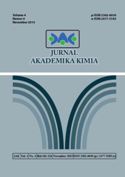- Focus and Scope
- Peer Review Process
- Publication Frequency
- Open Access Policy
- Archiving
- Publication Fee
- Copyright and License
Focus and Scope
Jurnal Akademika Kimia is an electronic open-access journal that aims to publish the latest research results in the area of chemistry education and pure chemistry from academicians, professionals, and other practitioners at all levels of chemistry education. The journal coverage includes the following: current trends of professional chemistry education, educational technology, teacher education, educational science, learning assessment, learning models and development of learning materials, as well as pure chemistry including organic chemistry, inorganic chemistry, analytical chemistry, physical chemistry, biochemistry and other chemistry fields such as environmental chemistry, that emphasis on a broad description of the general methods and processes for the synthesis, modification, and characterization of chemical materials.
Peer Review Process
Peer review is an integral part of scientific publishing that confirms the validity of the science reported. Peer reviewers are experts who volunteer their time to help improve the journal manuscripts they review.
Jurnal Akademika Kimia (JAK) follows a single-blinded peer review process, following the practices of good scholarly journals and to ensure impartial editorial decision making.
1. Submission of Paper
The corresponding or submitting author submits the paper to the journal. This is usually via an online system. Occasionally, Jurnal Akademika Kimia may accept submissions by email.
2. Editorial Office Assessment
Jurnal Akademika Kimia checks the paper’s composition and arrangement against the journal’s Author Guidelines to make sure it includes the required sections and stylizations. Once the article passes through this step, articles are subjected to editorial review for focus and scope, relevance, and other standard requirements.
3. Appraisal by the Editor-in-Chief
The Editor-in-Chief checks that the paper is appropriate for the journal focus and scopes and is sufficiently original and interesting, and then assigns an Editor who handles the peer review. If not, the paper may be rejected without being reviewed any further.
4. Invitation to Reviewers
The section editor sends invitations to individuals he or she believes would be appropriate reviewers. As responses are received, further invitations are issued, if necessary, until the required number of acceptances is obtained.
5. Response to Invitations
Potential reviewers consider the invitation against their own expertise, conflicts of interest and availability. They then accept or decline. If possible, when declining, they might also suggest alternative reviewers.
6. Review is Conducted
The reviewers read it closely and provide individual critiques, usually within one to two weeks. The review is then submitted to the journal, with a recommendation to accept or reject it – or else with a request for revision (usually flagged as either major or minor) before it is reconsidered.
7. Editor Journal Evaluates the Reviews
The section editor considers all the returned reviews before making an overall decision. Depending on reviewer commentary and recommendations, manuscripts may be sent back to authors for revision. After the section editor receives the revised manuscript, it is assigned to the reviewer(s) once again, for approval of changes. But the final decision to publish is made by the Editor-in-Chief.
If the paper was sent back for revision, the reviewers should expect to receive a new version, unless they have opted out of further participation. However, where only minor changes were requested this follow-up review might be done by the section editor.
Publication Frequency
Jurnal Akademika Kimia is published 4 (four) times a year (February, May, August, and November) which includes articles of the latest scientific work in English in the fields of Chemistry Education and Chemistry. Each issue contains 8 to 10 articles which comprise 200-250 pages.
Open Access Policy
Jurnal Akademika Kimia is open access journal which means that all content is freely available without charge to users or / institution. Users are allowed to read, download, copy, distribute, print, search, or link to full text articles in this journal without asking prior permission from the publisher or author. This is in accordance with Budapest Open Access Initiative and adheres to the best practice and high publishing standards
Archiving
This journal utilizes the LOCKSS system to create a distributed archiving system among participating libraries and permits those libraries to create permanent archives of the journal for purposes of preservation and restoration. More...
Publication Fee
All articles published in Jurnal Akademika Kimia are open access and freely available online, immediately upon publication. This is made possible by an article-processing charge (APC) that covers the range of publishing services we provide.
Jurnal Akademika Kimia charges the following fees.
Article Submission: 0.00 (IDR)
Article Publication: 300,000.00 (IDR)
If this paper is accepted for publication, you will be asked to pay an article publication fee to cover publication services.
Copyright and License

This work is licensed under a Creative Commons Attribution-NonCommercial-ShareAlike 4.0 International License.
Jurnal Akademika Kimia adopts an Open Access policy complying with the definition laid out by the Budapest Open Access Initiative (BOAI). This Journal is licensed under a Creative Commons Attribution-NonCommercial-ShareAlike 4.0 International License. This license allows the author(s) to hold the copyright without restrictions and the authors will retain publishing rights without restrictions and allows others to share the work with an acknowledgment of the work's authorship and initial publication in this journal.














